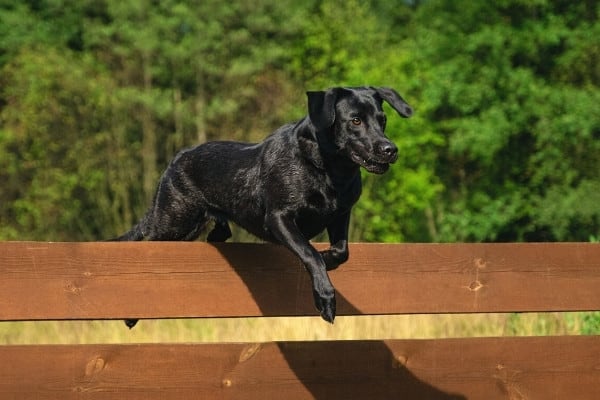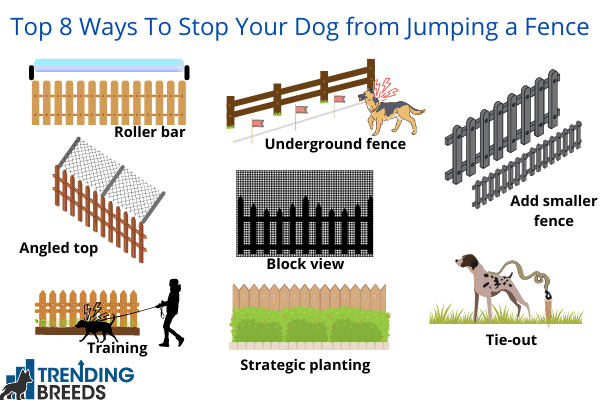
In many instances, dogs jump a fence to escape when either they’re new to the home and not settled yet or are faced with a newly fenced-in yard.
With these scenarios, the dog views the fence merely as a slight inconvenience on their path to freedom. However, dogs can and will jump a fence for a multitude of reasons.
While you can’t control the world around you and the various attractants that lure your dog off your property, you can improve your fence to prevent your dog from being able to scale it.
How do you keep a dog from jumping a fence? Installing roller bars or a tall piece of angled fencing to the top of the fence are the most effective ways to prevent a dog from jumping or climbing over a fence. An underground electric fence is another viable option. Remove any jumping aids and always supervise when the dog is outside.
Ensuring that your dog can enjoy some outside play time in the safety of your yard is your responsibility as a dog owner, but that’s not always as easy as it seems.
Many dogs are natural escape artists, but don’t lose hope.
In the following, we’ll share some inexpensive solutions to prevent your dog from hopping the fence and go over fundamental steps that will help keep your pup safely at home where he belongs.
Initial Steps
Before taking drastic measures or undergoing major yard renovations, take care of the basics first.
These initial steps may not be the sole solution to your problem, but they are nonetheless important and should not be overlooked.
They are fundamental to not only the health and well-being of your dog but are also crucial components when it comes to keeping your dog safely on your property.
Have Your Dog Spayed or Neutered
If your dog is unaltered, schedule the neutering procedure at once. Sex drive is a powerful motivation for dogs to jump over a fence in search of a mate.
It may take a few weeks for the hormone levels to dissipate after the surgery, so know that it could be a while before you notice a change in behavior.
However, it’s absolutely worth doing, especially for dogs driven to leave the yard in search of “true love.”
Provide Plenty of Exercise
All dogs need some form of exercise daily. This could be in the form of a long walk, a few short walks, vigorous play time, jogging, swimming, a trip to the dog park, etc.
Simply putting your dog out in the backyard, however, does not count as giving him exercise, and this is where many dog owners go wrong.
Ensure that your dog receives approximately 30-45 minutes of exercise every day.
The actual time and intensity will vary based on your dog’s size, fitness, and age, but the general idea is that a well-exercised dog will not have the pent-up energy that drives him to want to escape and run free.
Ensure Your Dog Receives Enough Mental Stimulation Daily
Mental stimulation goes hand-in-hand with physical exercise. Dogs need opportunities to exercise their mind in order to prevent boredom, which often leads to bad behavior.
Provide puzzle toys (like this one with sliding tabs and hidden compartments), teach new tricks, bring him to dog-friendly stores, play hide-and-seek, go for a hike – whatever it takes to enrich his mind with predicaments to work through and new things to explore.
- 【Size】: L9.44" * W9.44"* H1.14" suitable for cats, puppies and small dogs.
- 【Interactive Dog Toys】This is a fun interactive puppy puzzle toy, which can easily become the...
You’ll find lots of creative ideas in our Guide to Mental Stimulation.
Make the Yard a Pleasant Place To Be
If your dog is comfortable and happy inside the fence, he’ll be much less likely to attempt an escape.
Be sure there is adequate shelter available, provide lots of toys, ensure he has easy access to fresh water, and give him a comfortable, weather-proof bed for relaxing.
Perhaps most importantly, spend lots of quality time with your dog when he’s in the yard. Having you there with him is often enough to dissuade any escape attempts.
Remove All Escape Aids
Try to look at your yard from your dog’s perspective.
What objects could potentially be used to assist when climbing over the fence? What could be used as a launching pad to give him that aerial boost?
Relocate any items you find to an area well away from the fence. Although it almost goes without saying, repair any weak or damaged areas on the fence itself.
Know What Your Dog Is Capable Of
For most dogs, a 6-foot tall fence is adequate. However, don’t underestimate your dog’s cleverness or ingenuity.
Watch him closely to understand how he manages to get over the fence.
Does he use a long, running start before jumping? Does he make a short dash and then climb over the top? Does he use the top of the fence to help complete the escape?
Knowing exactly how he finds his way out will be a huge help in determining which solution is best for you.
Never Leave Your Dog In the Yard When You’re Not Home
This tip should be a no-brainer, but many people routinely leave their dogs outside alone despite the risks. This is a recipe for disaster.
Bring your dog inside or place him in a secure crate or kennel in a protected location whenever you must leave home, even if it’s just for a quick errand.

Install Rollers on Top of Fence
Dogs who use the top of the fence for a foothold when going over will be stopped by this method if it is done properly.
Two tubes are strung onto a wire between fence posts. When the dog jumps up, the outer tube spins, preventing the dog from gaining a secure hold.
There is an alternative to this strategy, and though it’s slightly easier to set up, it tends to be less effective.
The variation involves cutting a slit down the length of PVC pipes and simply tacking them to the top rails of your fence.
The smoothness of the pipe’s surface hinders the dog from getting the necessary grip on the top rail.
Steps:
- Install one L-shaped bracket on either side of each fence post (the sides parallel with the fence). Place them high enough so the pipes will remain midair even when the cable sags under applied pressure.
- For each fence section, have two pieces of PVC cut to size, one 1 inch in diameter and the other 3 inches. Sand cut edges.
- Attach thick braided wire to the first bracket using a cable lock. Stretch the wire to the next bracket, estimate how much extra length you need to secure it to the bracket, and cut.
- Insert one of the 1-inch pipes into a 3-foot pipe, and run the free end of the cable through the smaller pipe.
- Pull the cable as taut as possible and secure it to the bracket.
- Repeat steps 3-5 for each section of fence.
Extend Fence Height & Angle the Top Inward
For dogs who get a running start and simply soar over the top of the fence, adding fence extensions is the way to go. It is equally effective for dogs who climb too.
Rather than adding an L-shaped barrier to the top of the fence as others often advise, create a barrier that extends at a 45° angle from the top of the fence, angled toward your yard.
The L-shaped extension may work for some dogs, but unless it’s long enough, determined dogs can easily jump over it, possibly injuring themselves in the process.
Steps:
- If you have a chain link fence, simply add fence extenders (find them here) to each pole, set them at a 45° angle, and attach fencing.
- For other fence types, take aesthetics into account, and determine what type of extension arms would fit your fence and landscape the best. The arms could be wood, metal, or even PVC pipes.
- Attach the extension arms securely to the fence at regular intervals at a 45° angle from the top of the fence.
- Secure a barrier to the top side of the extension arms. Wire fencing, hardware cloth, plastic netting, and even lattice could work.
Train Dog To Stay Away From Fence
Dogs are more intelligent than you might think. It is entirely possible to train a dog to stay away from your fence, but it will take time and dedicated effort on your part.
The key is to make your dog understand that jumping up on or trying to jump over the fence results in negative consequences.
These consequences could be a sharp tug on the leash, a loud abrasive noise, a mild electric shock, or simply your disapproval.
If you aren’t confident that your dog will remain obedient in any situation, training him not to jump over the fence should be done in conjunction with another of the listed solutions.
Depending on your experience with dog training, it may be in your dog’s best interest to enlist a professional dog trainer.
Steps:
- Put your dog on a long lead – long enough that he can roam freely around the yard and have access to his favorite escape spots. While holding the end of the lead, allow your dog to wander at will.
- Whenever he approaches the fence or appears to be looking for a way over it, give the lead a sharp tug and say “No!” loudly or use an air horn or something similar.
- If you’re using an electric training collar, like this humane yet effective device, issue a warning beep. If he approaches the same spot again, provide a strong vibration correction or a mild shock, depending on the dog.
- Repeat these steps over and over again, making sure to provide lots of praise and a small treat when he stays away from the fence and to correct him when he ventures near it.
- Do not leave the dog unattended in the yard, even after you assume he’s fully trained.
Use an Invisible Dog Fence
An electric, invisible dog fence can be very effective. These systems use a transmitter, a receiving collar, and an underground wire.
When the dog approaches the established boundary, he is given, depending on how you program it, either a warning beep or a harmless corrective shock.
There are many similar models to choose from, but I have first-hand experience with this one and can attest to how well it works.
I especially like that there are seven correction levels and a beep-only option. It can be used for multiple dogs, with each dog’s settings separately controlled.
- Elite: The eXtreme Dog Fence MAX GRADE KIT Covers Up to 25 Acres with the Widest Signal Field...
- Waterproof and Submersible: Most Other Inground Dog Fence Systems Claim to be "Water Resistant". The...
Steps:
- Lay out the wire a foot or so from the fence, all the way around the fence line.
- Set up the transmitter indoors and follow package directions. Adjust settings.
- Test that the collar works correctly and as programmed.
- Dig a shallow, narrow trench several inches deep, and bury the wire.
- Place small flags along the wire’s path to help the dog learn the boundaries.
- Fit the collar on your dog according to the directions, and begin training.
Block Your Dog’s View
This suggestion is best used along with another solution, but it’s worth mentioning as many dogs are less likely to go after what they can’t see.
Ideas:
- Add plastic slats to a chain link fence (available here in a variety of colors and lengths).
- Use reed screening (like these attractive 13-foot rolls).
- Install outdoor privacy fencing (find 50-foot rolls on Amazon here).
- Beige Fence Slat - Designed for a 6' high fence, slats are approximately 68.5" in length to...
- Made in the USA. 30-year limited warranty. Lasts much longer than wind screen or privacy tape.
- Reed fences are amazing in color and opacity, plus they are easy to install,moisture and protects...
- SIZE - Comes in a roll. Natural Fresh Water Peeled & Polished Reed Fencing Panel. 3.3' H x 13.3' L....
- Privacy Solution: Most economical way for privacy over chain link fence, porous decorative...
- High quality material: privacy fence screen is constructed of sun protected HDPE fabric with durable...
Plant Shrubs, Trees & Vines Strategically
Although this method isn’t an instant fix for everyone, it can be useful over the long-term when plants reach their full height.
Additionally, well-placed plantings can hide other escape-proofing devices over time.
Consider planting thorny bushes or sturdy plants that fill out quickly and will block access to the fence in a relatively short time frame.
Add a Shorter Interior Fence
For dogs who use a running start to scale the fence, this solution may be the ticket.
By adding a second, shorter fence a few feet in front of the existing one, you prevent the momentum needed for a high jump.
As a bonus, installing this additional fence gives you the perfect landscaping opportunity.
Fill the area between the fences with beautiful plants, and no one will suspect that the short fence is really there for your dog.
Resort To a Dog Tie-Out
A dog tie-out should only be used when all else has failed.
With any dog tie-out, it’s imperative to use a reputable device that resists tangles.
Also, you must be certain that there are no obstructions in the area that could potentially cause entanglement. Never leave a dog unattended when using a tie-out.
If you go this route, one of the safest designs out there is the 360° SUREswivel.
It can withstand up to 1,000 pounds of pull force, has a unique dual-swiveling design, screws into the ground or a permanently structure, and can hold multiple dogs at once without tangling.
- Safe and Effective Tangle Free Pet Tether
- Full 360 Degree Dual-Swivel Motion
Wrapping It Up
Depending on your particular fence, you can likely modify it within just a few hours to keep your dog safely inside.
For extremely determined dogs, your best bet will be to use a combination of two or more of the above options, and never leave an escape-artist dog alone outside, even after you’ve secured the yard.
Last update on 2024-04-15 at 15:49 / Affiliate links / Images from Amazon Product Advertising API










